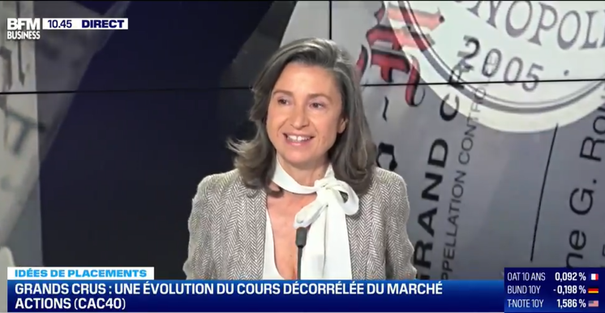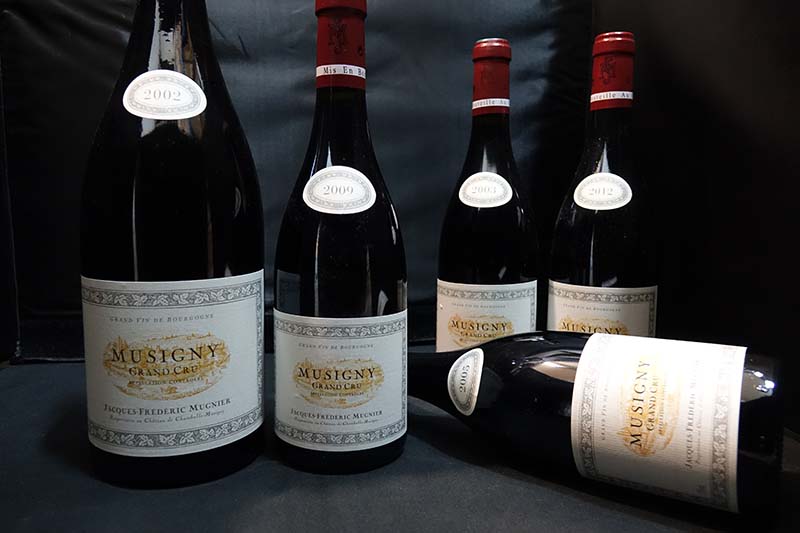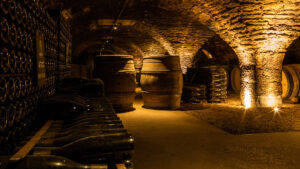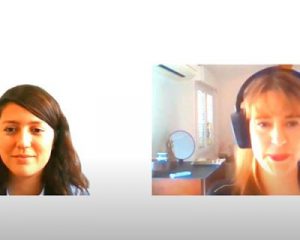
Every month, Angélique de Lencquesaing speaks to Cédric Decoeur about the latest developments in the fine wine market. This time, she answered questions about the differences and similarities between the stock market and the world of fine wine investment.
You know all about the market, having first worked at Euronext before founding iDealwine. So, are we currently looking at a bubble forming in the fine wine market, such as those that can happen in the stock market?
A big question…though I have to say that we’re a long way from the financial markets at iDealwine.
Having said that, the risk of inflation hasn’t escaped our attention, especially in the case of supply not matching up to demand to follow this market growth. The prospect of an increase in policy rates floated in the US early May – to avoid overheating the American economy – caused a brief moment of panic on the stock markets. Overall, though, businesses are doing well with record growth…but I’ll let you unpack all that with other specialists.
Do you see a link between the fine wine market and the stock market? What does the iDealwine index say?
Since 2007, when we first established the iDealwine index, and even more since the 2008 financial crisis, the value of fine wine has not progressed in correlation with the stock market, or at least with the CAC 40 (French stock index).
Of course, the calculation of our wine indices has its own particularities – linked to the specificities of the wine market, like the slow cash flow and the rolling vintages system – that have brought the indices up. This increase correlates with the price increase of wines just released from their domain, then reflected in the secondary market. This is why the iDealwine 100 index has grown by 247% since 2007, whilst the CAC has stayed relatively stable.
So is wine always a safe investment?
As is the case for certain alternative products, wine is ‘counter-cyclical’ in a way. If we look at 2021, the CAC 40 is overheating and has grown much quicker than the iDealwine indices.
The world of fine wine has taken up the role of safe investing in the long term. But we have to be careful because not all wines have had the same kind of success at auction and demand has really evolved over the last 15 years.
You’re talking about the Bordeaux vs Burgundy rivalry, I take it…
Yes, it’s true that this has been a striking development on the wine auction market. In terms of value, Burgundy has taken the top spot from Bordeaux, representing 37% of iDealwine sales in 2020 compared to Bordeaux’s 34%. And for quite a few years now, it’s been a Burgundy grand cru at the top of the ranking for highest priced bottles.
On the stock market, we can see what contributes to rising exchange rates. Is it the same for wine?
The factors that contribute to the increase in wine value at auction have something in common with the stock market: they are determined by the relationship between supply and demand.
However, what encourages demand on the stock market includes business grounds, sector-specific considerations, the general state of the economy etc. Similar for wine but not the same, elements at play include a search for quality and the desirability of certain regions, as well as the general state of the economy.
Another importance factor in fine wine is the tension added by the rarity of the products. This depends on the size of a given domain as well as the gradual consumption of bottles (when the wines are uncorked, this leads to a decrease in the quantity available.
Faced with a shortage in supply, the global circle of wine lovers hasn’t stopped growing.
Coming back to my initial question: is there a speculative bubble for wine? Particularly for Burgundy wines?
The auction market in general is showing a significant price effect in the long term: between 2015 and 2020, the volume of wine auctioned at iDealwine has increased by 104%. In value, this increase is 163%. A major price effect.
And Burgundy is THE region for rare fine wine. It ticks all the boxes for an attractive purchase, and is therefore subject to a demand that supply can’t totally fulfil.
Does that mean we should buy just any bottle with Burgundy on the label?
It’s not as simple as that! In Burgundy there are several categories of wine, including grands crus and iconic names. The price of these bottles has reached stratospheric levels. Last month, a bottle of 1986 Romanée-Conti sold for over €10,000, and this is a regular occurrence.
But watch out! For wines of this calibre, we’ve noticed that prices have stagnated at a really high level. Romanée Conti, La Tache, Corton-Charlemagne from Coche-Dury, wines from Roumier and Rousseau all sell quickly at high but stable and unsurprising prices.
Have these wines reached their price limit then? Will they gain any more value?
For now, these prices are stable, which doesn’t mean that value will never increase again. Perhaps we’ll have to wait until more of the bottles have been opened, as this increases the rarity of those still in the market. For the domains just mentioned, Armand Rousseau for example, the mature vintages are on the rise.
Which wines are enthusiasts seeking then, if Burgundy is so attractive?
We’ve notice that enthusiasts are expanding their search and choosing domains based on the following criteria:
- Tiny production (La Romanée from Domaine Liger Belair)
- Wines in the natural movement (Domaine Bizot)
- Wines from domains that have since been passed on or by wine makers who have since passed away (Henri Jayer, Jacky Truchot)
These are still top domains though, right?
Yes, we’re still pretty much looking at icons here, but their prices keep going up for the reason listed above.
What’s interesting, though, is that in 2020 the average price of Burgundy bottles at auction fell slightly from €193 to €188. Bidders are after the icons of tomorrow.
Some examples?
Already well-known are Cécile Tremblay, Chandon de Brilailles, Clavelier…among others that we’ve listed in detail in our Auction Barometer.
Aside from the top names, have prices continued to rise in Burgundy?
No, we should be wary of over-marketed wines; some of the generic Burgundy cuvées from good domains, for example, are now difficult to sell. The temptation for a domain to increase its prices is strong, but they shouldn’t to trick their clients.
Certain bottles from other regions have reached incredibly high prices at auction, like the Loire and the Languedoc, have you noticed anything speculative about this?
There is a recent phenomenon that I want to come back to. One of the most exciting things about our auctions is the colossal amount of data that we can analyse. Over 175,000 bottles were auctioned on our platform in 2020, which is a lot of material to go off. This means we can point out the stars of tomorrow based on atypical bidding patterns, and this is how we spotted the Languedoc’s star domain!
La Grange des Pères, whose owner abruptly left us recently.
Exactly. When Laurent Vaillé’s death was announced, there was an outpouring of emotion. Lots of wine enthusiasts, including many who had never tasted Vaillé’s wine, wanted to acquire a bottle. At the same time, many retailers took these wines off their lists. They became unfindable.
Except at auction?
Exactly. We had some bottles from Grange des Pères that were put on the website before Laurent Vaillé’s death. Prices skyrocketed, with one bidder buying a recent 2017 vintage for over €700. Immediately, critics were outraged. Are we dealing with speculation here? We think it’s more that people want to try the wine. And actually, to calm the debate a bit, it’s worth mentioning that this frenzy has already cooled off.
Can this ‘collector’ aspect be a reason for a sudden, speculative rise in prices?
This rests on the idea that a bottle is totally impossible to reproduce, even if the climate where identical. So yes, there can be speculation once this is fuelled, constructed by a ratchet effect on starting prices. We refuse to base out starting prices on the latest highest bid, but rather on a value taken as a median of recent auction results. Any rise in price is, thus, only seen after a certain time, and only if the phenomenon persists.
Are there some other collector domains on the auction market at the moment?
Yes, there are quite a few. Some that spring to mind are Henri Jayer in Burgundy, Didier Dagueneau, Clos Rougeard (mature vintages), Henri Bonneau in Châteauneuf, Gentaz Dervieux in Côte-Rôtie, Noël Verset in Cornas…But we should note that the proportion of bottles auctioned from these domains is tiny, they don’t make up the base of our activity. It’s just as exciting to consider who the stars of tomorrow will be.



